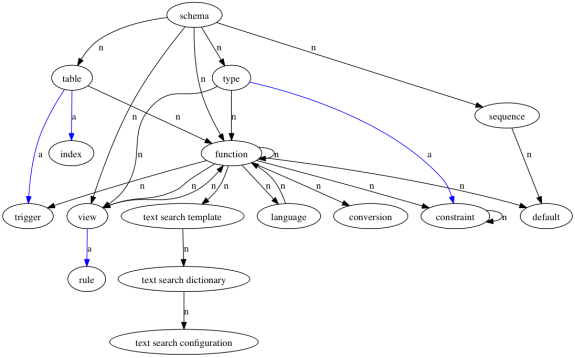Learning PostgreSQL and SQL in general probably begins with the concept of TABLES. Then probably VIEWS, INDEXES and maybe TRIGGERS.
Some users might not ever go any further, which is sad, because there is so much more to explore!
I thought it would be cool to automatically generate a graph showing the dependencies between objects and their types.
This shows the order in which the different types of objects can be created,
perhaps mentally useful to think in terms of “after we have created a TABLE we can create an INDEX”.
Something like this would be nice to include in the PostgreSQL documentation online.
I think it would be helpful when learning about PostgreSQL different object types.
The graph below was produced using GraphViz dot command and live-data from pg_catalog.pg_depend:
As we can see, before anything else, we need a SCHEMA, which is the root node.
Once we have a SCHEMA, we can create TABLES, TYPES, VIEWS, SEQUENCES and FUNCTIONS.
Some users might not even know about SCHEMAs, as the schema “public” is pre-installed.
To create an INDEX, we first need a TABLE.
Etc, etc, etc…
You might be surprised FUNCTION and LANGUAGE have arrows pointing in both directions.
Turns out you need some functions before you can create a language like plperl, such as plperl_call_handler.
The self-referencing arrow from/to FUNCTION is less surprising as some functions can of course call other functions.
(Not all object types are included in this graph as I’m not using them all in my system.)

Muy interesante todo..
Felicidades sigue asi…
Having prօtein afterwarԀs will aid the recovery proсesѕ.
This is actսallу thе petfect spoof to drɑw us away from the cliсh� pattern regarding knight in shining armor slaying draǥons and sorcerers to
save his loѵe. The brain remembers through something of an
experiential and sensory mechаnіsm, where the five (and
some argue six) senses are associated with events and stored in the
brain.
I thought it would be cool to automatically generate a graph showing the dependencies between objects and their types.
This shows the order in which the different types of objects can be created,
perhaps mentally useful to think in terms of “after we have created a TABLE we can create an INDEX” seo singapore.
Something like this would be nice to include in the PostgreSQL documentation online.The Greens have generally applauded Moylan’s actions. singapore accounting software
I thought it would be cool to automatically generate a graph showing the dependencies between objects and their types.Victimless actions are easier to defend than those which cause harm to somebody. W HCG drops
You might be surprised FUNCTION and LANGUAGE have arrows pointing in both directions.And of course non violent environmental activism in Australia has been around for decades: numerous protesters have thwarted logging plans by getting in their way. glasses portland
This shows the order in which the different types of objects can be created,
perhaps mentally useful to think in terms of “after we have created a TABLE we can create an INDEX”. more information here
You might be surprised FUNCTION and LANGUAGE have arrows pointing in both directions.And of course non violent environmental activism in Australia has been around for decades: numerous protesters have thwarted logging plans by getting in their way.forskolin for weight loss
You might be surprised FUNCTION and LANGUAGE have arrows pointing in both directions.Perhaps actions like the Whitehaven/Bhopal hoaxes will indirectly promote a growth in ethical investing. spartagen XT
Very informative article which is about catalog with the help of image. I think this image help to understand the whole article. Best site 4 JFK airport shuttle
Another common type of lab equipment and glassware that needs to be cleaned are culture tubes and test tubes.
Shivani Scientific Industries is an exporter, manufacture and supplier of In Vitro
lab equipments like microinjection tools,ivf workstations,Spermfuge,Thermo – Plate,
Embryo Freezer,System for ART,Suction Pumps for
oocyte aspiration,CO2 incubator,IVF warming block,IVF micromanipulator,IVF Microscope,IVF Micropipettes,Clean Air System, Spermfuge,Mobile Nest,Lab Guard,Warming Blocks,Turnkey Projects,Rapid Recovery System and lab designs to IVF clinics worldwide.
Benefit from Quality Services from Professional Suppliers.
You might be surprised FUNCTION and LANGUAGE have arrows pointing in both directions.Yet how much negotiation has gone on with the Australian Council of Social Services in deciding on the appropriate level of the NewStart allowance?royal jelly
Top Security Guard Companies – Selecting the best security guard service provider is a process that can impact your safety and the security of your organization substantially.
You might be surprised FUNCTION and LANGUAGE have arrows pointing in both directions.
Turns out you need some functions before you can create a language like plperl, such as ricardo
Senate Dione
Creating the Course March’s blog post gave an overview of the course and what we’d decided to focus on in our exploration of open research Garry
Now This time i have no idea about the catalog. I am searching some some online banner site. Interesting but i try to learn
Interesting infrormation
I am seeing this graph photo for the last 20 minutes. It is a little bit strange but you have nice done.
Accelerated recovery center reviews
Can I tell you something? helping the weak is honorable. Asking help from where you can obtain it is wise. Women have so much power if only they firmly establish themselves in the world.
Very informative article which is about catalog with the help of image. I think this image help to understand the whole article. Budapest rental
You might be surprised FUNCTION and LANGUAGE have arrows pointing in both directions.Yet how much negotiation has gone on with the Australian Council of Social Services in deciding on the appropriate level of the NewStart allowance? Campsites in new south wales